![]()
![]()
![]()
Use LEFT and RIGHT arrow keys to navigate between flashcards;
Use UP and DOWN arrow keys to flip the card;
H to show hint;
A reads text to speech;
42 Cards in this Set
- Front
- Back
|
The _____ question requires society to decide on the combination of resources to produce output.
|
How
|
|
|
In a _____ system, consumers and producers make economic decisions acting in their own self interest.
|
market
|
|
|
By definition, _____ is a system in which the resources are publicly owned.
|
socialism
|
|
|
How income is distributed amongst the members of society answers the ______ question.
|
for whom
|
|
|
An _____ is what is given up in order to gain something else.
|
opportunity cost
|
|
|
_____ explains why the production possibilities curve is not a straight line.
|
The law of increasing costs
|
|
|
_____ is illustrated by an outward shift of a production possibilities curve which means that an economic system is able to produce more output.
|
Economic growth
|
|
|
By definition, _____ is a system in which th resources are privately owned.
|
capitalism
|
|
|
The _____ question asks which goods are to be produced in what quantities.
|
what
|
|
|
In addition to more land, labor, and capital, an economy can realize economic growth from _____ with other countries and _____.
|
trade, technology.
|
|
|
A _____ illustrates the opportunity costs faced by a consumer.
|
budget line model
|
|
|
A country has a _____ and gains the most output from its resources when it specializes in producing an output in which it has a low opportunity cost and trades for an output that has a high opportunity cost.
|
comparative advantage
|
|
|
A model that illustrates the opportunity costs faced by a producer is called a _____.
|
production possibilites curve
|
|
|
Th purpose of an _____ is to allocate a society's limited resources.
|
economic system
|
|
|
T/F Under socialism, economic decisions must be made according to a plan.
|
F
|
|
|
T/F Compared to a market system, resources are more efficiently allocated in a planned system.
|
F
|
|
|
T/F There are no opportunity costs if something is free.
|
F
|
|
|
T/F The production possibilities curve is concave because resources lose productivity when switched to another production.
|
T
|
|
|
T/F An inward shift of the production possibilities curve means that an economy is experiencing an enefficient use of resources.
|
F
|
|
|
T/F A country can gain output or grow if it trades with other countries for an output it has a low opportunity cost in producing.
|
F
|
|
|
T/F The WHAT question is answered in a market system by the amount of income each person has.
|
F
|
|
|
T/F The opportunity costs of a producer become greater as more of an alternative output is produced.
|
T
|
|
|
An opportunity cost
a)does not exist if something is free. b)only counts if the lost opportuntiy has monetary value. c)includes time not devoted to an alternative use. d)decreases when resources are switched from another output. |
c
|
|
|
A planned system
a)enables producers to answer the HOW question. b)is more efficient than a market system. c)can be used with capitalism. d)is being adopted by more countries every year. |
c
|
|
|
The amount of income (affordability) consumers earn in a market system answers the
a)WHAT question b)HOW question c)WHY question d)FOR WHOM question |
d
|
|
|
a
|

Which of the point movements represents an opportunity cost or an increase in entertainment for less clothing?
a)B to C b)G to F c)C to B d)D to C |
|
|
b
|
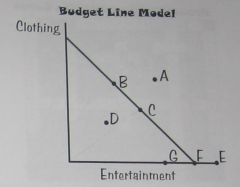
An increase in movie prices while clothin prices do not change would be represented by a point movement from
a)A to B b)F to G c)F to E d)C to B |
|
|
d
|
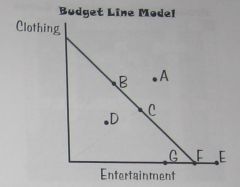
A movement from point D to point C would represent
a)an opportunity cost of less clothing. b)a decrease in entertainment prices. c)an impossibility. d)spending all of the money available for clothing and entertainment. |
|
|
a
|
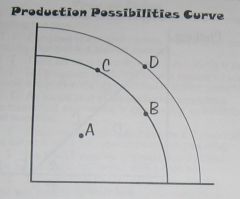
Which of the points on the model represent an enefficient use of resources?
a)A b)B c)C d)D |
|
|
b
|
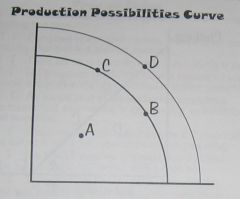
Which of the point movements on the model represent an opportunity cost?
a)A to B b)B to C c)C to D d)D to B |
|
|
d
|

In order for an economy to reach point D, or realize economic growth, it must
a)lower the unemployment rate (not at full-employment). b)use resources that have been idle or unemployed. c)decrease trade with other countries. d)experience an increase in resources. |
|
|
Term for the expenditure or borrowing to purchase capital.
|
Investment
|
|
|
The economic question for which goods and services to produce.
|
What
|
|
|
The economic question for which goods and services to produce.
|
What
|
|
|
The cost of the next best alternative.
|
Opportunity Cost
|
|
|
One of the factors that promotes economic growth. (10 letters)
|
Technology
|
|
|
An outward shift of the production possibilities curve.
|
Economic Growth
|
|
|
The _____ shows the combination of two outputs that can be produced given limited outputs.
|
Production Possibilities Curve
|
|
|
The basic economic question of who recieves goods and services.
|
For Whom
|
|
|
Analysis used by economists to determine the effect or outcome of producing or consuming more than one unit.
|
Marginal
|
|
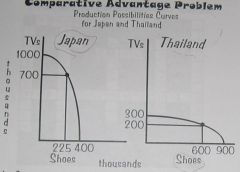
Calculate the opportunity costs of producing shoes and televisions for Japan and Thailand.
|

^Solution^
|
|
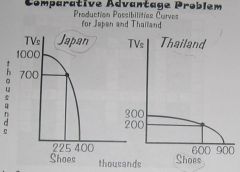
Determine the gains from trade if each country specializes in producing the output that it has a comparative advantage in.
|

^Solution^
|

